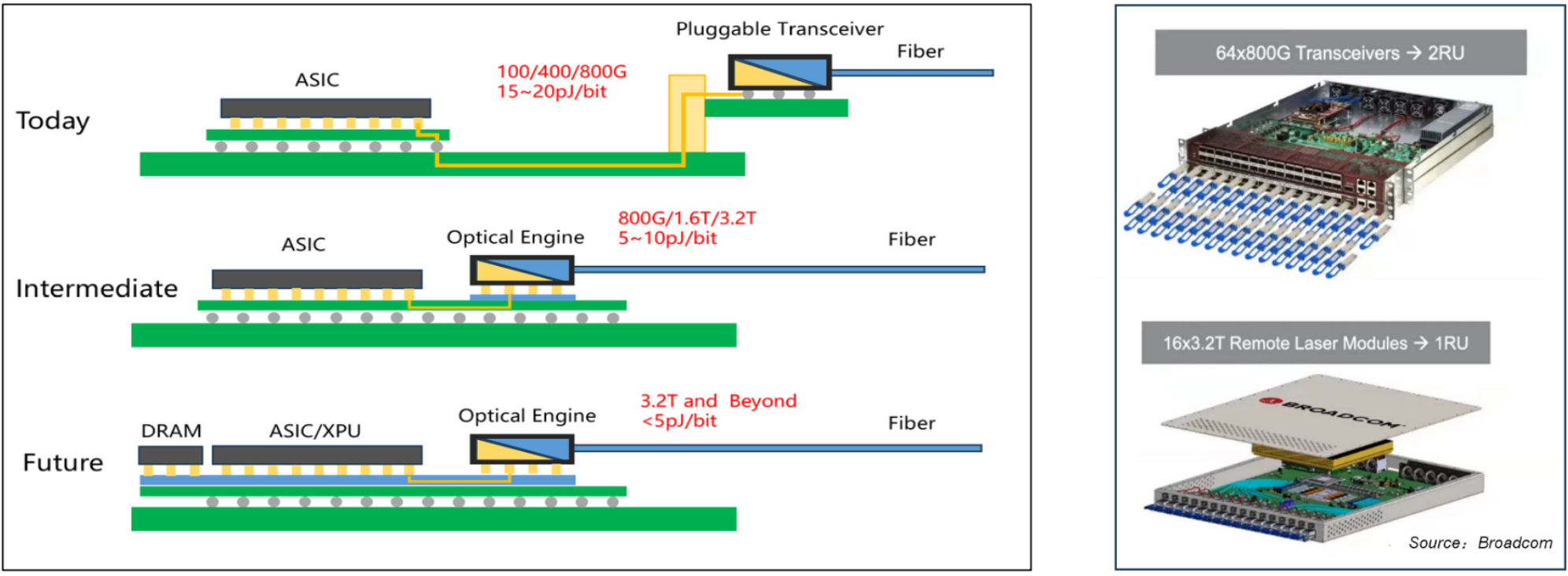Co-Packaged Optics
Since 2020, CPO has gradually shifted from academic research results to products meeting market demands. Leading companies in the industry, such as Intel, Broadcom and Marvell have introduced the products based on CPO. Other enterprises are actively entering the field, advancing CPO technology standardization. Cloud service providers Facebook and Microsoft have established the CPO Alliance, aiming to create a platform to attract leading companies from various sectors to join the alliance, promoting the establishment of CPO standards and the development of products.
Co-Packaged Optics (CPO) is an innovative technology revolutionizing networking and data centers by integrating optical communication components directly into the package of a network switch or router.
This departure from traditional architectures eliminates the need for external optical transceivers, reducing latency, enhancing bandwidth, and optimizing power efficiency. Co-Packaged Optics offers improved scalability and space utilization, crucial in high-demand data center environments. By shortening signal paths and tightly coupling optical components with networking chips, it promises higher data rates and better signal integrity, addressing the challenges posed by the increasing demand for high-speed, low-latency connections in applications like artificial intelligence and high-performance computing. While still evolving, Co-Packaged Optics represents a significant advancement with the potential to reshape the landscape of modern data center architectures.
| Company | Develop Progress |
| Intel | In 2020, the company showcased the industry's first switch product based on CPO technology, incorporating the 12.8Tbps Barefoot Tofino2 chip and a 1.6Tbps optical engine in a joint package. In 2021, the company collaborated with Ayar Labs to package the FPGA chip Stratix10 and five optical IO TeraPHY chips together on a 16-layer organic substrate, achieving a multi-chip package with 8Tbps bandwidth. In 2022, the company reported the latest collaborative achievement with Ayar Labs, utilizing FPGA and silicon photonic chips to create an optical IO link, marking the first validation of a 5.12Tbps bandwidth signal interconnect. |
| Cisco | The company pursued the development of CPO through the acquisitions of three major silicon photonics enterprises: Lightwire, Luxtera, and Acacia. In 2020, Acacia introduced a 400G silicon photonics module solution. Initially, discrete optical components were integrated into a PIC (Photonic Integrated Circuit) chip, which was then combined with a self-developed DSP (Digital Signal Processor) chip on an SOI (Silicon-On-Insulator) platform. Ultimately, an external laser was integrated to package the entire assembly into an optical module. Acacia also collaborated with chip manufacturer Inphi in the CPO technology domain, with plans to launch a 51.2Tbps switch based on CPO technology in the future. |
| Cisco | In 2022, the company launched the Teralynx7 switch, which is based on 2.5D CPO (Chip-on-Package) technology and boasts a throughput of 12.8Tbps. In 2023, a new platform was introduced, featuring the Marvell Teralynx10 51.2Tbps switch chip with ultra-low latency. Additionally, this platform includes the industry's first PAM4 (Pulse Amplitude Modulation with 4 levels) 1.6Tbps optoelectronic platform called Marvell Nova. |
| BroadCom | The company expanded its CPO development through the acquisitions of optical device companies Luminent and Broadlight. In 2022, they unveiled their first CPO switch at OFC (Optical Fiber Communication) by packaging the 25.6Tbps Tomahawk 4 switch chip and optical components together. In 2023, the latest switch product, Tomahawk StrataXGS 5, was introduced. This switch leverages CPO technology to package the switch chip and 100G PAM4 (Pulse Amplitude Modulation with 4 levels) interfaces together. It achieves a switch capacity of 51.2Tbps while consuming only 5.5W of power. |
Copyright © Samba Labs
Fast Navigation
—

